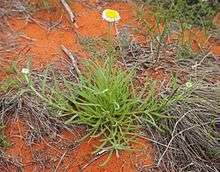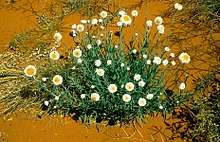Polycalymma
Polycalymma stuartii, the poached egg daisy, is an Australian daisy found abundantly on sand plains and dunefields.[2] Its common name is derived from the poached egg-like appearance of its white flower and yellow centre. It is the only known species of the genus Polycalymma; a member of the pussy's-toes tribe within the daisy family.[3][4][5] [6][7]
| poached egg daisy | |
|---|---|
 | |
| Polycalymma stuartii | |
| Scientific classification | |
| Kingdom: | |
| (unranked): | |
| (unranked): | |
| (unranked): | |
| Order: | |
| Family: | |
| Tribe: | |
| Genus: | Polycalymma |
| Binomial name | |
| Polycalymma stuartii | |
| Synonyms[1] | |
|
Myriocephalus stuartii (F.Muell. & Sond. ex F.Muell. & Sond.) Benth. | |
Origin
The poached egg daisy was named after McDouall Stuart[8] and is Indigenous to a large area of Central Australia. The first scientific description was written in 1853.
Alternative names [9]
- ham and eggs daisy
- fried egg plant
- bachelors' buttons
Habitat
The Poached Egg Daisy is found abundantly during good seasons in open communities on sand plans and dune fields[10] in Western Australia, Northern Territory, South Australia, Queensland, New South Wales and Victoria[11][12]. This annual daisy thrives in light to medium soil, open sunny communities and is resistant to drought and frost.

Physical Characteristics[9][13][14]
Cotyledons
Two (dicot) narrow lance shaped cotyledon with a tapered base, pointed tips, edges that convex to parallel and a hairless surface.
First leaves
Narrow lance shaped first leaves with pointed tips and covered in dense short hair.
Leaves
Alternating leaves with no petiole. leaves are a light green colour, measure 20-70mm long with narrow parallel sides to lance shape with pointed tip, present woolly hairs on upper side and sticky hairs on underside and have smooth edges.
Stems
Stem is erect and stout, standing 100-500mm tall, somewhat tufted ad is woolly or very sticky with glandular hairs.
Flower head
Flower heads are compound, hemispherical and white with a yellow centre resembling a poached egg and measure 20-40mm in diameter.
Fruit
Black cylindrical achene that are woolly or silky with long white hairs.
Roots
Taproot system.
Ecology
8 week lifecycle
References
- Flann, C (ed) 2009+ Global Compositae Checklist
- "Plants at the AALBG: Poached egg daisy, (Polycalymma stuartii)". Friends of the Australian Arid Lands Botanic Garden. 2012.
- Mueller, Ferdinand Jacob Heinrich von & Sonder, Otto Wilhelm. 1853. Linnaea 25: 494 in Latin
- "Tropicos | Name - Polycalymma F. v. Mueller & Sonder". www.tropicos.org. Retrieved 2018-05-16.
- "IPNI Plant Name Details". www.ipni.org. Retrieved 2018-05-16.
- "Friends of the Australian Arid Lands Botanic Garden - Plants: Poached egg daisy, Polycalymma stuartii". www.australian-aridlands-botanic-garden.org. Retrieved 2018-05-16.
- Australia, Atlas of Living. "Polycalymma | Atlas of Living Australia". bie.ala.org.au. Retrieved 2018-05-16.
- Government, Northern Territory (2018-03-25). "Poached egg daisy". alicespringsdesertpark.com.au. Retrieved 2019-06-10.
- "Poached-egg Daisy". www.herbiguide.com.au. Retrieved 2019-06-10.
- "Friends of the Australian Arid Lands Botanic Garden - Plants: Poached egg daisy, Polycalymma stuartii". www.australian-aridlands-botanic-garden.org. Retrieved 2019-06-10.
- "COMPOSITAE (R) – Bushland Conservation Pty Ltd". Retrieved 2019-06-10.
- "Tree Element /tree/51308853/51245324". biodiversity.org.au. Retrieved 2019-06-10.
- "Factsheet - Polycalymma stuartii". keys.lucidcentral.org. Retrieved 2019-06-10.
- "PlantNET - FloraOnline". plantnet.rbgsyd.nsw.gov.au. Retrieved 2019-06-10.